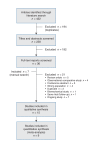Operative versus nonoperative interventions for common fractures of the clavicle: a meta-analysis of randomized controlled trials
- PMID: 26770963
- PMCID: PMC4701658
- DOI: 10.9778/cmajo.20140130
Operative versus nonoperative interventions for common fractures of the clavicle: a meta-analysis of randomized controlled trials
Abstract
Background: The popularity of surgery for acute displaced midshaft clavicle fractures has been fuelled by early randomized controlled trials (RCTs) showing improved rates of radiographic union and perceived functional benefits compared with nonoperative approaches. We performed a meta-analysis to determine the effect of operative and nonoperative interventions on the risk of secondary operation and complications and on long-term function.
Methods: We search MEDLINE, Embase and the Cochrane Central Register of Controlled Trials for reports of relevant RCTs published to Mar. 7, 2014. Two reviewers assessed eligibility of potential reports and the risk of bias of included trials. The Grading of Recommendations Assessment, Development and Evaluation approach was used to summarize the quality of evidence for all outcomes.
Results: We included 15 RCTs (9 trials comparing operative and nonoperative interventions, 5 comparing implants for operative treatment, and 1 comparing nonoperative treatments). Nonoperative treatments did not differ from operative treatments in the risk of secondary operation (risk ratio [RR] 1.16, 95% confidence interval [CI] 0.58 to 2.35) or all complications (RR 0.90, 95% CI 0.55 to 1.50). One in 4 patients had a complication regardless of the treatment approach. Differences in functional outcomes, although smaller than the threshold for minimal important differences at 1 year, favoured operative interventions (standardized mean difference 0.38, 95% CI 0 to 0.75). Evidence for the type of implant or approach to nonoperative treatment remained inconclusive.
Interpretation: Current evidence does not support the routine use of internal fixation for the treatment of displaced midshaft clavicle fractures. Complication rates were high regardless of the treatment approach.
Conflict of interest statement
Figures






Comment in
-
Treating fracture of the clavicle.CMAJ. 2016 Apr 5;188(6):403-404. doi: 10.1503/cmaj.150962. Epub 2016 Feb 22. CMAJ. 2016. PMID: 26903360 Free PMC article. No abstract available.
References
-
- Lenza M, Johnston RV, Belloti JC, et al. Surgical versus conservative interventions for treating fractures of the middle third of the clavicle. Cochrane Database Syst Rev. 2013;6:CD009363. - PubMed
-
- McKee MD. Clavicle fractures in 2010: Sling/swathe or open reduction and internal fixation? Orthop Clin North Am. 2010;41:225–31. - PubMed
-
- Nordqvist A, Petersson C. The incidence of fractures of the clavicle. Clin Orthop Relat Res. 1994:127–32. - PubMed
-
- Nowak J, Mallmin H, Larsson S. The aetiology and epidemiology of clavicular fractures. A prospective study during a two-year period in Uppsala, Sweden. Injury. 2000;31:353–8. - PubMed
-
- Robinson CM, Goudie EB, Murray IR, et al. Open reduction and plate fixation versus nonoperative treatment for displaced midshaft clavicular fractures: a multicenter, randomized, controlled trial. J Bone Joint Surg Am. 2013;95:1576–84. - PubMed
LinkOut - more resources
Full Text Sources
Other Literature Sources
Medical
